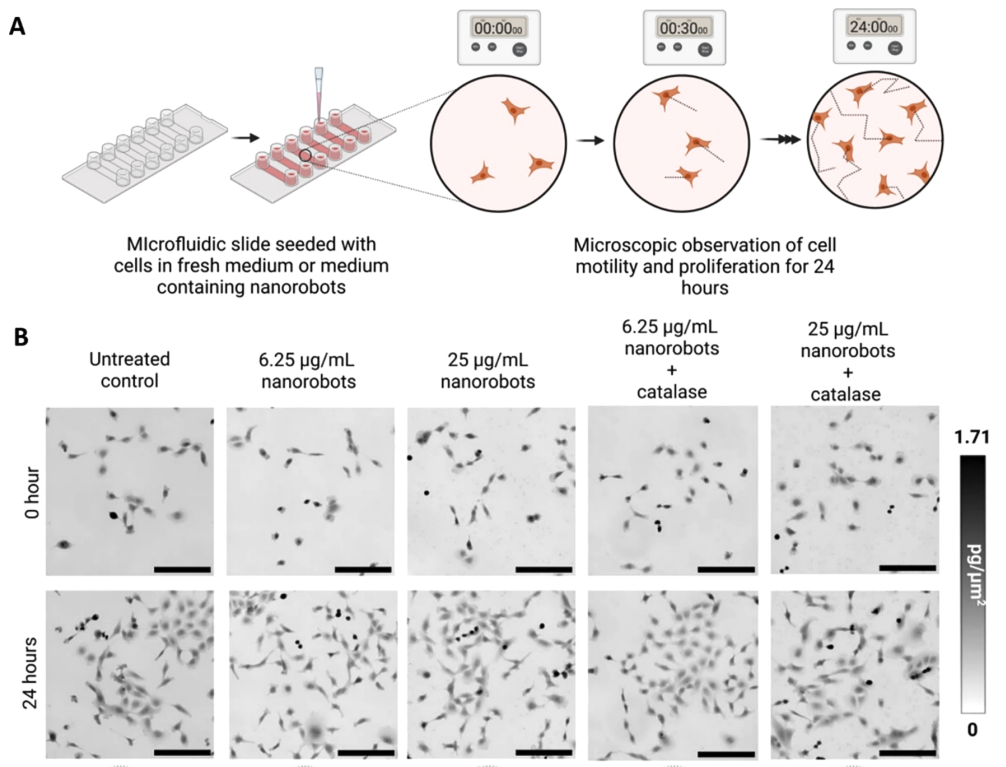What are glucose-powered nanorobots?
Glucose-powered gold-silica (AuSiO₂) nanorobots are designed to mimic natural cellular communication with the environment by producing a steady-state concentration of hydrogen peroxide (H₂O₂) from glucose as a fuel. They are made of “naked” gold nanoparticles (NPs) attached to aminated silica (SiO2) cores. Nanorobots engineered in this manner perform two catalytic roles at once: they oxidize glucose to produce H₂O₂ and then decompose the H₂O₂ into water and oxygen. The produced H₂O₂ serves as an essential signaling molecule, enabling nanorobots to communicate with cells.
AuSiO₂ nanorobots synthesis

Summary of the findings
For future biomedical applications, nanoparticles are evolving beyond simple drug delivery systems. Instead of just transporting molecules to cells, they’re being designed to actively interact with their surroundings – sending and receiving biochemical signals to influence cellular behavior. Previous studies have shown that H₂O₂ can control cell behavior, but the trivial enzyme production of H₂O₂ was shown as unstable and making it difficult to maintain a precise steady-state concentration of H₂O₂. Therefore, the authors of the study developed AuSiO₂ nanorobots that mimic the catalytic activities of natural enzymes – nanozymes.
Experimental results on HT1080 cells indicate that the concentration of nanorobots plays a key role in cellular communication. At lower doses, nanorobots with the steady-state generation of H₂O₂ effectively stimulate both cell migration and proliferation. In contrast, higher doses slow down cell proliferation. For tracking cell movement, proliferation, and the diffusiophoretic behavior of nanorobots, the team employed quantitative phase imaging (QPI) and microfluidic gradient assays.
Altogether, the article guides the assembly of nanorobots and their integration into cellular microenvironments by generating H₂O₂ in situ to modulate cell behavior. The scientists present the idea of using nanorobots as localized, noninvasive biochemical command systems and highlight their potential in regenerative medicine applications, such as wound healing.

The terms used in article
Nanoparticles are extremely small particles, typically between 1 and 100 nanometers in size. They can be classified based on their composition material, such as carbon-based, metal-based (e.g., Au, Ag), oxide-based, ceramic, polymeric, etc. Due to their small size, they have unique physical and chemical properties. Nanoparticles are used as drug carriers and imaging agents in medical applications because of their large surface area, high reactivity, and special optical properties.
Nanorobots are extremely small machines, typically operating at the scale of nanometers, that are designed to perform specific tasks within microscopic environments. They can interact with biological systems, sense and respond to stimuli, and in some cases deliver drugs. Many nanorobots are constructed using nanoparticles.
Gold–silica hybrid nanoparticles that mimic enzyme catalytic activity to produce and degrade H₂O₂. They promote cell migration through the generation of a steady-state H₂O₂ signal.
A controlled level of hydrogen peroxide is maintained over time, used here as a signaling molecule to control cellular processes.
An enzyme that catalyzes the decomposition of H₂O₂ into water and oxygen. In the study, it was used to verify that the effects observed are due to H₂O₂ signaling.
Cell dry mass [pg] refers to everything inside a cell except water. It consists mainly of proteins, lipids, and other biomolecules. It is often reported as cell dry mass density, which represents the amount of dry mass per unit area in the image plane and is measured in picograms per square micrometer [pg/µm²].
How Did Q-Phase Contribute?
“Random walk” assay was performed with the Q-Phase system – an experimental approach used to study how individual cells move over time. As a result, QPI revealed differences between nanorobot-induced migration and proliferation.
- Motility evaluation: High-quality, trackable data from QPI allowed researchers to monitor both the motion and proliferation rate of the cell population. They calculated motility parameters such as displacement, distance traveled, speed, etc., to assess motility changes caused by the nanorobots.
- Revealing dose-dependent effects: The data demonstrated how the concentration of nanorobots affects cellular behavior.
- Confirming H₂O₂ dependence: Thanks to QPI in experiments with treatments of nanorobots and catalase, the researchers could confirm that the observed effects were driven by the steady-state H₂O₂ signal. When catalase was added, QPI data showed reduced motility and restoration of normal proliferation rates, proving the role of H₂O₂.
- Quantifying cell proliferation: Cell dry mass measurements provided by QPI enabled accurate calculation of cell doubling times.
Quantitative Phase Imaging and cell migration
If you’d like to explore more about nanorobots in research, you can also read how they are helping with prostate cancer treatment article by other Q-Phase users. And if you want to dive deeper into using QPI for your migration studies, we suggest that you watch the webinar above.